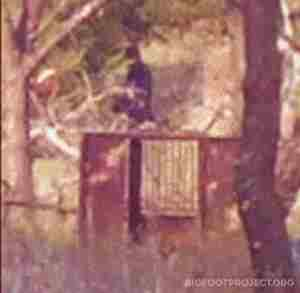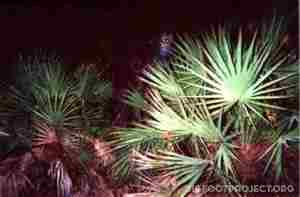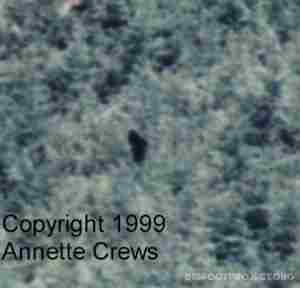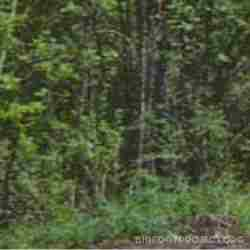

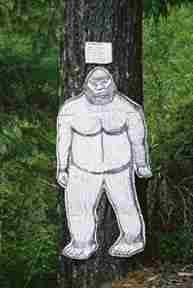


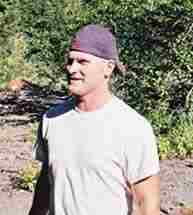













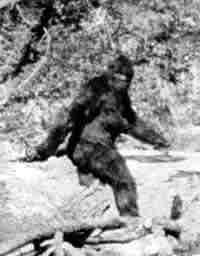
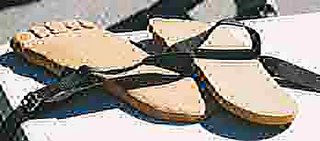


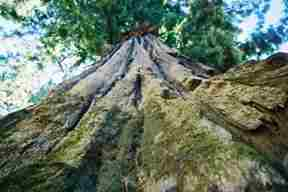
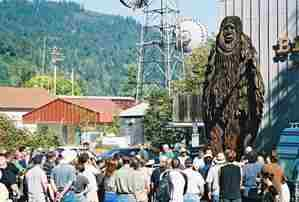



Willow Creek, California September 12-14th 2003
By Paul Vella (with notes by Jerry Riedel)
Editor's note: Since Paul wrote his original article, a set of DVDs has been released by the BFRO in which all but one of the presentations can be seen. It is available on their website.
Back in 1972, I was little more than a toddler, when the BBC screened a documentary called ‘Fabulous Animals’, which changed my life forever.
The documentary, which some of you will have seen, showed what is one of the most closely studied 58 seconds of film ever made, second only to the Zapruder film. The film in question was of course the Patterson-Gimlin Film of a ‘bigfoot’, filmed on October 20, 1967 in Bluff Creek California.
Over the years, I have read almost every book on the subject, and have corresponded with literally hundreds of people across the world. I have tracked down some of the worlds rarest books on the subject, and even have a signed first edition of John Green’s seminal work Sasquatch: The Apes Among Us (which has now been reprinted by Hancock House).
So, you can imagine my reaction when I found out about the first International Bigfoot Symposium to be held in Willow Creek – after seeking permission from my wife, and promising to do all the ironing for the next year, I booked a flight to San Francisco. I called the Bigfoot Motel in Willow Creek, and discovered to my horror that all the rooms were already booked, so I decided on a campervan rental instead.
The date came, and on 10th September 2003, I landed in San Francisco, sorted out the details of the camper rental and hit the road. Once north of San Francisco, I took the beautiful coastal road north, stopping overnight in Bodega, the small town where Alfred Hitchcock filmed ‘The Birds’. The schoolhouse and church are still there, and don’t appear to have aged one bit.
Sequoia semperviren - otherwise known as the Redwood
The following day I continued my drive north, eventually moving off the highway onto the ‘Avenue of the Giants’, a 32 mile stretch of road that parallels the highway, and takes the driver right through the middles of 60% of the worlds tallest trees, namely the Sequoia semperviren, otherwise known as the Redwoods - if you haven’t seen these magnificent trees, then you need to add them to the list of things to do before you die.
Looking up at a pair of these giant trees, I couldn’t help but be reminded that the date was 11th September 2003 –two years to the day since another pair of giant towers fell.
I stopped and met "bigfoot" friends from Arizona (Dave) and Washington (Jerry) at the Samoa Cookhouse in Arcata on the coast. This is the last remaining logging cookhouse in the United States, where Dave told us the story of how he had taken his pickup truck down to the Bluff Creek film site the previous Monday and got stuck down there after the rain, making the road back up impassable. He camped there for three days, and told us that he was just a little nervous at times. After dinner, I headed inland to Willow Creek, arriving there around just before midnight. It was too late to start looking for a campsite, so I parked in the China Flats Museum car park for the night.
Day One
Having arrived after dark, I wasn’t quite prepared for the sight that greeted me in the morning – Willow Creek was surrounded by steep wooded hills, and looked more like an alpine village than a Californian town – the rest of California may have been debating whether or not to elect Arnold Schwarzenegger for Governor, but believe me, no-one here was going to care. The mist was slowly lifting, so I went off to find some more friends who had been lucky enough (or so I thought) to get a motel room.
We chose what was possibly the slowest diner on the planet for breakfast. Actually, ‘Sherries’ is the only diner in Willow Creek, so it was either that or a doughnut from the gas station.
Press conference prior to Symposium
The full panel of speakers.
At the table next to us was sat John Green, Dmitri Bayanov, Jimmy Chilcutt, Thomas Steenburg, Jim McClarin, Dr. John Bindernagel, Bob Gimlin, Dr. Jeff Muldrum and a couple of other people I didn’t recognise. These were the giants of sasquatch research, and I felt like I was a small child in Disneyland. This was going to be an incredible weekend.
Breakfast over, and there was a press conference to take care of back at the museum. The speakers were lined up, and the press received an explanation that we were not crazy folk, but actually people who for scientific reasons believed that there was an as yet unknown ape roaming the forests of North America. I don’t know whether the press believed them or not, at this stage I couldn’t care less.
The China Flat Museum in Willow Creek is small – it is named after the ‘flat’ area of land where the Chinese workers lived (you’ve got to love Americans for their simplicity). Most of the small museum contains local exhibits, logging photos etc., and then there is the
small bigfoot room, which contains a number of plaster casts, a copy of Dr. Grover Krantz’s Gigantopithicus Skull reconstruction, a short video and newspaper cuttings. This particular weekend, the so-called Skookum Cast was also on display – more about that later.
Since the museum was so small, the Symposium organisers had commandeered the use of the local school gym for the weekend – this being a Friday, we had to wait until after lunch before the talks could start.
We recorded the parts of the symposium lectures, but in true Fortean fashion, all the audio recordings were unintelligible when we listened to them later. It was an extremely hot weekend, and the organisers had installed a couple of very large (but still ineffective) fans, which was just about the only sounds picked up by the recorders. Jerry Riedel spent the weekend busy with his notepad, and has allowed me to use his notes, which I have largely reproduced here (Thanks a million Jerry).
...
Keynote Speech
John Green opened the Symposium in the spot originally reserved for Jane Goodall. "Even though I have the same initials as her,” Green said, “it is a great misfortune that Miss Goodall was unable to attend as her stature might have caught wide notice."
John Green, Keynote Speaker
Dr. Jane Goodall had been slated to give the keynote address, but instead was meeting government officials from the Democratic Republic of Congo to discuss habitat preservation. Interestingly, she was instead supposed to provide a video address, but that failed to materialise – rumours suggested that her advisors had steered her away from having any involvement in the weekends proceedings.
However, Dr. Goodall did later participate in the production of the BFRO produced Symposium DVDs.
Green dedicated the Symposium to the memory of Bob Titmus, noting that Titmus had almost single-handedly started the field of bigfoot research, bringing to Willow Creek, Ivan T. Sanderson, as well as Green himself. Green told us that many of the items on display in the museum were donated by Bob's wife, after Titmus' death.
Green believes Sasquatch represents a single form of "bi-pedal wildlife" - and made the following points about the Sasquatch phenomena:
* The story of Sasquatch is one that can't be shaped to fit our fantasies...we must be willing to change our "image" of Sasquatch to fit the facts.
* We are dealing with an animal...and the study of Sasquatch will require more then one cadaver for dissection purposes.
* Green believes Sasquatch is an animal, because, not only of what he has learned in his years of study, but because of what science has learned of human origin.
* There is nothing new about claims of detailed viewing of Sasquatch, or for that matter, people who see, or smell, something every time they go into the woods. Every researcher has his, or her, cross to bear... "mine is the Albert Ostman story." he told us.
* But there are detailed, as well as seemingly reliable accounts. Glenn Thomas and William Roe, for example. Ruby Creek, which came to light in 1957, produced a casting almost identical to a casting in Bluff Creek, CA.
Green went on to give us a summary of the cases he has personally investigated over the years. Of 3,647 cases in Green's files, only 40 have a male and female together. Smell is mentioned in only 72 reports, with 14 described as "strong," 4 describe a "mild" smell, while 26 reports mention no smell from a distance of 10' or less. Green believes any smell may be a "fear odor" as described by Diane Fossey. Green went on to say that 1,182 of his sightings were by hunters, loggers, or hikers. The most common sighting is "the one seen on the side of the road."
Wallace-like wooden feet carved by John Green.
Green told us that whilst it was very tedious entering all the information from his card files into his computer, that it was worthwhile, as it started to show certain trends such as migration, time of day, time of year, moon phase, etc.
You will recall that the death in 2002 of bigfoot hoaxer Ray Wallace led to numerous newspaper reports that "Bigfoot was Dead". On the subject of Ray Wallace, Green said the first paper to print the story reported it in a responsible manner, "but the rest of the press was highly irresponsible.” Green went on to say that the Wallace family doesn't even know how the fake footprints were made.
One of the main factors against the Wallace claim is the fact that the discovery of the tracks in the Bluff Creek area strongly interfered with Wallace's contract to construct Bluff Creek Road, costing Ray Wallace money, as he started losing construction workers, causing the construction to run overtime.
Green warned researchers to be wary of associating themselves with people that claimed that they habituated with bigfoot – it was clear that he was referring to Mary Green’s ridiculous book 50 Years With Bigfoot: Tennessee Chronicles of Co-existence.
Green ended his address by telling the delegates that when it came to bigfoot research, he was the past, and that this symposium was all about the future. When I spoke to Green later, he said that he never imagined that there would be no resolution to the mystery some thirty years after the publication of his final book. He says he is too old to continue at the pace he has been working, and wants to hand his records over to an organization that will use them properly.
...
Dr. John Bindernagel
Apelike anatomical and behavioural characteristics of the Sasquatch
Dr. John Bindernagel started his talk by asking, “What is it that makes people think they've seen Bigfoot and not an upright bear?”
He summarised the answers as follows:
* Long arms, short neck, flat face
* Female creatures seen
* Short thick neck
* Large nostrils (like a gorilla)
* Pointed (or somewhat pointed) head... "a sagittal crest" - an attachment of muscles to the upper jaw
* Sagittal crests may occur in either male or female gorillas, with size appearing to be the determining factor
* Deep-set eyes (an almost mythological description)
* Pursed lips (seen in NW totems and in pictures of chimps)
* NW totems exist with a thunderbird on top and a Wild Man of the Woods on the bottom
* Wild Giants of the mountains throw rocks at viewers, as do chimpanzees
* Chest-beating (as the gorillas do) are seen in Sasquatch
* The tracks are prime evidence... "tracks often appear as if something was walking on a tightrope"
Dr Bindernagel did however go on to say that people believe in bigfoot, or sasquatch, "because they like to believe in it!"
It should be noted that Dr. Bindernagel’s presentations and papers have been rejected by wildlife meetings and seminars "due to recent stories in the press" (apparently referring to the Ray Wallace stories)
...
Dr. Jeff Meldrum
Midfoot flexibility, footprints and the evolution of bipedalism:
Perspectives on the Patterson-Gimlin film
Dr. Jeff Meldrum began his talk by telling us that the hallmark of the hominoid locomotor system is the grasping toe.
Dr. Meldrum gave a fascinating talk about the mid-tarsal break in apes and his research into it - used as a test ape was "Jason," walking repeatedly across a box filled with sand, to get an example of the mid-tarsal break. After trying the sandbox test the first time, Jason was put into a holding cage, watching as Meldrum and Jason's handler raked the box smooth.
Following his second attempt walking through the sandbox, Jason looked back at the holding cage, then at Meldrum and his handler (Jason's, not Meldrum's), then back at the holding cage. Jason then went back to the box, and erased his footprints with his hands!
Human footprints show a pressure ridge just behind the toes. Bigfoot tracks seem to indicate the presence of a mid-tarsal break.
Following the Patterson/Gimlin film, Patterson chose to cast tracks, which were too "perfect" - so flat that nothing could be learned from them. Lyle Laverty took a series of photos, which show a mid-tarsal break (tracks show up very well in Bluff Creek soil). Bob Titmus cast 10 consecutive tracks, one of which was the same as in the Laverty photo.
Meldrum concludes, "The Patterson film shows flat-footed mid-tarsal breaks and bipedalism!"
Meldrum went on to show us a Blue Creek Mountain "half-cast" of a 1967 track which "clearly shows mid-tarsal breaks.", and a Blue Mountains, WA ('96) photo which shows toe slippage and typical front half-track.
Dr Meldrum ended his talk by saying that he believed that "Hominids may have been bi-pedal for over three and as much as seven million years."
...
Jimmy Chilcutt
Dermal ridge evidence in footprint casts
For me, Jimmy Chilcutt’s talk was the most fascinating – many of you already know that I work as a Forensic Examiner and Expert Witness, so for me, it was interesting to see another expert witnesses "Evidence".
"My basic job” Chilcutt began, “is to take one fingerprint from a crime scene and match it to one from all the millions on file."
Chilcutt said that he noticed during an investigation, that cocaine packages are generally wrapped in numerous layers. By carefully unwrapping these packages, Chilcutt was able to isolate prints, on each of the layers, which ultimately led to convictions. The Federal organizations picked up on this very quickly and now Chilcutt works with the FBI, DEA, ATF, and all sorts of "alphabet" organizations.
Chilcutt is a man with a curious mind, and whilst his future research into human fingerprints was going to be unpopular, it is important to us. Chilcutt wondered whether human fingerprints contained any sexual or ethnic characteristics that could be used as an aid in identifying individuals. He was somewhat successful, and states that he can say with an 85% certainty whether a fingerprint is male or female, black or white, but ran into some difficulties as a result of interbreeding of races (it is easy to see how his work could be deemed as being politically incorrect).
As part of this study, he began taking prints from primates (because they don't interbreed.) After being turned down by several zoos, He started with the Yerkes Primate Center, telling inquiring minds he was "investigating the theft of a truckload of bananas!", and found that humans and primates share the same characteristics - arches, loops, and whorls. They are simply present in different configurations.
Chilcutt said that he lived alone at the time, and because he didn’t have a wife to nag him, was sat eating his dinner in front of the TV one night with a beer, half-watching the Discovery Channel, when he hears Dr. Jeff Meldrum utter those two words which brought Chilcutt into the bigfoot field – “Dermal Ridges”. Chilcutt called Meldrum the next day, and eventually spent three days examining casts from Meldrum’s vast collection.
Chilcutt came away from those three days convinced "...there is an undiscovered North American ape!"
The first cast had dermal ridges, but had been double-tapped, by using human fingerprints to make the toe prints look better. He put that cast aside.
The Walla Walla, WA casts (13-inches long) exhibited "clear ridges with characteristics", with ridges going down the side of the cast.
He went on to explain that human ridges go across the foot and then fade away, and primate ridges run across the foot at an angle.
To Chilcutt's surprise, he found the ridges on the Walla Walla cast ran down the cast on the bottom of the foot, but also on the side of the cast. The ridges on the cast were also "twice the thickness of human dermal ridges."
A Walla Walla cast from 1987 displays the "same texture of ridges as some Northern California casts.”, cast some twenty years and hundreds of miles apart.
In addition, he has found dermal ridges on a cast from Georgia... faint ridges, again running down the side of the foot, and explains that the Skookum Cast shows dermal ridges running down the sides of an Achilles Tendon.
Chilcutt said dermal ridges are not present on every cast... but on casts made before 1999, he is convinced that no one could have known the significance of ridges. But casts made after that date could be made knowing all the information Chilcutt has brought to the field of bigfoot research.
The following day I caught up with Chilcutt in a corridor, and asked whether his involvement in the bigfoot field had harmed his reputation as an Expert Witness in any way.
“Absolutely not” he said in his soft-spoken Texan accent “If a defense attorney were to ask me about it in open court they know they would be given the same presentation I gave yesterday, which would only reenforce my particular expertise”.
Chilcutt and I agreed that one of the most frustrating aspects of bigfoot research was the poor handling of evidence, and that it needs a good shake up, so that field researchers treat footprints, film, photos etc. as real forensic evidence, and are collected and handled in a forensically sound manner.
I firmly believe that Jimmy Chilcutt is the best thing that has happened to bigfoot research in years.
...
We broke for a Samoan smoked salmon dinner, but since one of our party was not keen on fish, we drove back into town and visited a diner. We bumped into some firefighters from the nearby Indian Reservation, who told us that there were more forest fires on Highway 299. A burger and a beer later, and we returned to the school
...
The Patterson-Gimlin Film Subject
Patterson-Gimlin footage: Another Look
Doug Hajicek explained that in 1994, while filming a documentary in the sub-arctic, he walked off the path to relieve himself and discovered 17-inch prints on the beach of a lake (with a 42-inch stride, 3-4 inches deep). The tracks went in a straight line, going "over seven foot tall trees" (tracks going on both sides of the trees).
He went back to the float plane pilot (named Wallace...much laughter at this point) and asked him if they could follow the tracks with the plane, upon which Wallace got angry with what he perceived to be a joke and hurled his clipboard. The subject was dropped.
In 1998, Hajicek contacted the Bigfoot Field Research Organization, and began the early work on what would become Sasquatch: Legend Meets Science. John Green lent him his first generation copy of the Patterson/Gimlin footage, and Hajicek had the film cleaned up and transferred digitally to a computer.
He quickly determined that there wasn't enough, with the P/G footage alone, to fill an hour documentary.
He spent hours in his basement looking at the digital footage on a High Definition monitor, concentrating mostly on the head of "Patty", when he began to notice a bulge, which appears then disappears on the right leg of the animal. He later discovered that there is an injury, which occurs predominately in women, called an Erectus Femoral Hernia, which is very similar to what can be seen in the P/G footage.
As part of the documentary, he shopped around and found a forensic animator willing to create a "digital skeleton" by "reverse engineering" from the footage. (The first bid came in at $300,000, another was $100,000, but Hajicek, due to budget constraints, was forced to take the lowest bid.)
The result was a skeleton, which appeared to walk in a manner completely different than the movement of humans. The knees would bend, with the legs splayed outward - then the knees bend in, in a knock-kneed fashion. The Peruvian-gait Horse (bred to walk up hills) is the only animal Hajicek has found that exhibit this manner of walking.
His conclusion - "No suit in 1967 (or today) could create this effect."
Other things noticed in the digital P/G footage:
* The hair appears to bristle when Patty looks at Patterson and Gimlin.
* Patty seems to favour her right leg.
* A scientist (who was sure the film was a hoax) agreed to watch the digital footage and was able to identify 40 different muscle groups on the animal. He couldn't give any explanation how that could be hoaxed.
During a question/answer period, he told the audience that, other than the footage in Sasquatch: Legend Meets Science, all images of the P/G film came from a third-generation copy of the film. (Both Chris Murphy and Danny Perez maintain the original footage still exists - but neither knows exactly where it is!).
When asked about the Ray Wallace claims near the end of the year, Hajicek disclosed that the Discovery Channel pulled all pre-publicity just one week before LMS was originally aired in January 2003. Despite the lack of publicity, the documentary was the first to grow in viewership during the hour broadcast.
...
Day Two
Line drawing of the Hairy Man pictograph
Mayak datat: An archaeological viewpoint of the hairy man pictographs
Kathy Moskowitz began her presentation by noting the differences between a pictograph and a petrograph - picto is carved into rock, while petro is painted on rock.
Near Tuleville, CA (in central CA), on the Yokut Indian Tribe's reservation, is a faded pictograph of what may be a family group of bigfoot. The pictograph was first written about by Mallory in 1889 and again in 1929... this time by Stuart. Both referred to the pictograph as The Hairy Man.
The male Hairy Man is depicted as 2.6 meters tall and six feet wide; the female is depicted as 1.8 meters high and 1.2 meters wide; the baby is depicted as 1.2 meters high and 1 meter wide. The baby is positioned under the females’ right hand, while the male is to right of the female.
Moskowitz drew a parallel to the Glenn Thomas sighting in Estacada, OR (1967) in which he saw an apparent bigfoot family searching through a pile of rocks for small rodents. Thomas described the small bigfoot as trying to stay as far away from the male as possible.
Editor's Note: Ms. Moskowitz has written an article for the Project based on her Symposium presentation.
...Photo evidence case study
Alton Higgins became interested in the subject of bigfoot following a fishing trip with his cousin, during which he found tracks and scat.
He started his discussion by noting that evidence can be divided into several categories:
* Testimony - anecdotal evidence
* Signs or indications - physical evidence
* Photographic - this category has "proof" problems; it is neither anecdotal, nor physical
Photographic evidence can be split into numerous categories:
* Obvious fakes
* More sophisticated fakes
* Unclear, but possible
* Equivocal image evidence
An investigator, as well as a casual person interested in this field, must always question any evidence presented - although it may not be easy to dismiss some images.
Higgins always looks at the three "C's":
* Context - always explore the context in which the photos were taken. They should not emerge from a void. Photos are only one manifestation and should parallel reports and other evidence. Other evidence may include hair - this is controversial. Samples taken in North America have been "identified" as primate. Footprints are a very good indicator. Handprints are found very rarely. No dermal ridges have been confirmed on handprint casts, as yet.
* Character - includes consistency, reputation, truthfulness, and motive (whether it be financial of fame/prestige)
* Clues - the ability to identify clues that can be evaluated from within the photograph itself.
For so called ‘confidentiality’ reasons, we were asked not to photograph the photos we were shown, but I have to say that they were not the most convincing photos I have ever seen.
That said, we were also presented with before and after photos, which showed that the humanoid shape in the woods was not there before or after, but that is pretty much all I can say on the matter.
Editor's Note: Mr. Higgins has written an article for the Project which expands on his Symposium presentation.
... The Skookum Cast
The Skookum Cast
In September of 2000, the Bigfoot Field Researchers Organization conducted an expedition in the Gifford Pinchot National Forest of Washington State. This expedition used various techniques and devices to try to lure a Sasquatch near enough to the base camp to establish thermal imaging. Rick Noll discussed the expedition and its results - a 200 lb. plaster cast of what appears to be the lower torso of a hair covered primate.
Noll gave a short history of sightings reported from the vicinity:
* 1847 - stories told of Mountain Devils
* 1924 - Fred Beck and the famous "Ape Canyon" story
* 1930 - tracks were photographed
more reports from '56, '64, '65' and '69.
Noll noted that there is a strong belief in Bigfoot's existence in the area, mentioning the Skamania County, WA ordinance banning hunting of bigfoot and Whatcom County, WA's declaration of a "Sasquatch Hunter-free zone"
The Skookum Expedition was a joint effort of the BFRO, the Discovery Channel, and Animal X (an Australian animal channel.) They used an early example of Thermal Imaging (black and white), as well as pheromone chips and sound blasting, using the "Tahoe Screams" as their calls, and baiting piles.
It has to be said here that I, like many others have seen the Animal X program, which I find interesting because this "expedition" showed us several people and camera crews driving into the mountains, using these pheromones to waft downwind of them, but it never seems to occur to any of the scientists and researchers that the smell of their pickup trucks, cooking, aftershave and urine will also waft downwind. No one had used the thermal imaging camera before, and they did not have sufficient battery power to use it for more than a few minutes. Despite that, it seems that they got lucky with one of their bait piles, which had been deliberately placed in an area with wet mud.
Skookum Cast heel imprint detail
The assumption was that a bigfoot would simply walk to the bait pile, leaving footprints to and from, but the resulting cast appears to show that the bigfoot sat down and leant across the wettest mud. Other body impressions have been found in the past, but none have been studied in such detail.
Multiple heel strikes (from two feet) were found; also found elk tracks, as well as coyote, on the top of the impressions. Dermal ridges were found on the "heel."
Noll showed a video of an elk kneeling down on the ground, folding its front legs beneath it before going to its knees, then repeating the process with its back legs, pointing out that if the impression had been made by an elk, then there would be footprints present under the body impression.
During the Q&A session, veteran bigfoot researcher Daniel Perez asked, "Are you 100% sure that the cast represents a bigfoot?" Noll simply answered, "No”. At this point, Perez furiously scribbled in his notebook, but did not write down what Rick Noll had to say next. “That would be stupid,” said Noll, “because none of us saw a bigfoot make the impression."
Dmitri Bayanov asked, "If not bigfoot, what else could it be?"
"I don't know," said Noll.
...
Dmitri Bayanov
Russian Hominology
Dmitri Bayanov emphasised two points from the start:
1. Almasty (Russian name for a bigfoot-like creature) is real
2. Folklore and mythology are both valuable sources of information.
He believes bigfoot may have migrated from Asia, across the Bering Sea, through Alaska, and from there spread out into North America.
He was unable to attend the Vancouver, BC conference (Conference on Sasquatch and Similar Phenomena), held in May 1978 (later written up as Manlike Monsters on Trial by Marjorie Halpin), because the Soviet authorities would not give him permission to travel. This was in fact his first visit to the United States.
I have to confess and say that I found Bayanov’s accent very difficult to follow – I’m sure his talk was very interesting, but I couldn’t make out much except to say that he believes the Patterson/Gimlin film is unique evidence, and that he hadn't seen any three-toed tracks in Russia, but has heard of some four-toed tracks.
...
The Sasquatch Skin and its Appendages
Much of Dr. W. Henner Fahrenbach’s presentation was a primer on human skin and frankly, fairly boring. But he did touch on bigfoot, however, since I fell asleep during this presentation, I am very grateful to my friend Jerry for filling me in on the details later.
Sasquatch Stench: He said most humans begin to smell after one or two days, "... so one can imagine how badly sasquatch could smell without washing."
Fahrenbach noted only about 105 of the bigfoot reports contain a mention of a smell. He said this may be an indication bigfoot may exude the smell when very excited or frightened, much like some male dogs give off a powerful smell from their anal glands.
His former director (at the Oregon Primate Research Centre) believed bigfoot couldn't possibly be real because the breasts, as seen in the P/G footage, were covered with hair. Fahrenbach felt this position contradicted a book written by the former director, in which he wrote, "Human breasts are covered with fine hair, as are other primates."
...
Pioneer Bigfoot Investigation Panel - Moderated Rudy Breuning
Bob Gimlin, Jim McClarin, Al Hodgson, Ed Schillinger and John Green were there in the late 1950s and 1960s capturing film, casting tracks, and investigating the bigfoot evidence of the times. They discussed their activities and answered questions about their involvement in bigfoot investigations.
There was a lot said during this panel discussion, so I will summarise as best I can.
Al Hodgson - "I just happened to be there in '58, '59, and '60... I thought it was a hoax, even after Bob Titmus cast prints." Hodgson said he began to believe when he found footprints on his own.
Bob Gimlin
Bob Gimlin - "I was a non-believer." He met Roger Patterson and got involved with riding around the country simply because he enjoyed riding. Gimlin said Hodgson was the only one, outside of the Patterson and Gimlin families, that knew of the Bluff Creek footage in the beginning. Patterson phoned Hodgson when they returned to Willow Creek, and said "Al, I’ve got a photo of the son-of-a-buck.”
Ed Schillinger - was a doctor in the area and heard of a number of encounters from his patients, including a few that came to him with cuts and bruises having run out of the forests having seen a bigfoot.
Mickey McCarty - in 1972, she had only read of bigfoot when her 12-year-old son ran into her room, saying he'd heard pigs out of their pen. He'd thrown open the drapes from the window and found himself just inches away from a bigfoot.
Three days later, her kids were sleeping in a tent, in the front yard, when a bigfoot came up to the tent. The kids shined a flashlight on the bigfoot, which ran away, leaving a stench, "which lasted for over a month."
She saw a small bigfoot from about 150 feet. She observed the sasquatch eating berries. When it became aware it was being watched, it "shot me a disgusted look and walked up a pathway up the hill."
Jim McClarin
Jim McClarin - Bigfoot researcher from the age of 17-26. McClarin is famous for carving the first bigfoot statue (located at the corner of Hwy's 96 & 299). He corresponded with Ivan T. Sanderson, Roger Patterson, John Green, and Rene Dahinden.
For him, the "fluidity of movement of the muscles, as well as the light reflecting off the hair" convinced him of the authenticity of the P/G footage. He and two others went to Bluff Creek to view the film site shortly after the film was shot and he was able to see tracks (in poor condition.) A comparison movie of McClarin, was shot walking along the track of 'Patty.'
Ed Patrick - lived in Hoopa, CA, in 1959. After Ray Wallace reported prints on Bluff Creek Road, Patrick and Bob Titmus went up and looked at prints "17-inches long and 7-inches wide." Patrick said he couldn't make a track on the sandbar - the large tracks were about a half-inch deep and five inches across at the heel.
Tom Slick, the Texas millionaire, became involved with a large-scale expedition (the PNWE), along with John Green and Ivan Marx. They noticed that bigfoot seemed to go down Bluff Creek around the 1st of November of each year. They set up cameras the next year. You guessed it, no bigfoot.
They observed, based on the tracks, bigfoot would crawl under logs rather than hop over them. A helicopter was hired and left gasoline on Oldfield Mountain. Patrick and Marx took a jeep to get the gas and got stuck in the snow. They saw tracks in the snow, coming down the hill, down the road, then turn off the road, and continue down the hill, disappearing out of the snow.
John Green - saw a picture of Jerry Crew holding a cast. Green went down to Willow Creek, with his wife. He saw prints and was very impressed. Bob Titmus mailed Green, who came back to Willow Creek and saw more tracks (covered with leaves). Saw more in '59 and in '63 saw tracks near Hyampom, CA. In 1967, Bud Ryerson called Green, saying, "What you're looking for is here!" over 600 tracks in a row. Green flew down, with a tracking dog and handler. The dog smelled the first track, "and it was an electric shock, the dog's hair, on his back stood straight up!" The dog refused to follow the tracks or scent. The tracks were in deep dry dust. Then it rained over night leaving a thin layer of dried-mud on the top. A Forest Service worker drove up to them and said, "I've never seen any bigfoot tracks in these woods."
"What about these?", Green asked.
A Q&A session followed.
The inimitable Daniel Perez rose to pose a tough question to Bob Gimlin:
Perez: Did you and Patterson stop to shower on the way from Bluff Creek to drop the film for shipment?
Gimlin: Danny...I can’t remember.
Perez: In all the publicity surrounding the original article about the footprints published in the Eureka newspaper, did the editor actually write that article?
Gimlin: No, it was Betty Allen.
Q: If Jane Goodall came on board the bigfoot 'field of investigation,' would that increase the likelihood of more money flowing into the field?
A: from Green... "It certainly wouldn't hurt." Much laughter from Hodgson, "I think the symposium has been OK with the money we've had." Much applause.
Q: For Bob Gimlin: Do you regret the day you agreed to go with Roger Patterson?
Gimlin: Not today, not then, but there have been occasions I've regretted it. My wife has taken a lot of ribbing.
And then came the question, from Andy Thomson, (Writer Director, Producer) that everyone really wanted to ask: “Mr. Gimlin, I know you have been asked this before, and will be asked this again, but would you mind telling us in your own words would you please recount your experiences on that October day in 1967?”
Gimlin went on to say that he and Roger were riding up Bluff Creek, on the right-hand side. “We came around a downed tree, the creek had re-routed around the tree. As we came around the tree, the horses reacted... to the presence of the creature. Roger's horse reared onto its rear, un-saddling Roger” Patterson it seems was not "thrown to the ground" as has been reported by many people – in fact, Gimlin went on to explain that Roger had practiced getting the camera out of the saddlebag over and over again, and when he realized why the pony was rearing, grabbed the camera dismounted and ran across the creek and up the sandbar.
Gimlin rode his horse across the creek, and "Patty" turned and looked at them just as Gimlin dismounted, with his rifle. “I never had an intention of shooting the creature."
Bob Gimlin not only silenced the room while he spoke, but also received the only standing ovation of the weekend.
...
Bigfoot at Bluff Creek
Sitting with Daniel Perez for much of the conference was a certain Lunetta Woods (not the name she used to enroll for the weekend) – a woman from Wisconsin, who spent the weekend talking to anyone who would listen about the Yetis in her back yard, who could be summoned by watching Harry and the Hendersons, and would shape-shift into birds and rabbits to avoid detection!
Lunetta published a book a few years ago called ‘Story in the Snow’, which you can find on Amazon if you really want to read more. When I read it last year, I had bought it ‘blind’ from Amazon, and honestly thought it was a children’s fiction book!
The BFRO produced DVDs of the symposium has a short video of Ms. Woods sitting in the parking lot debating yetis and shape-shifting with Steenburg – it is very entertaining.
When I bumped into Daniel Perez later whilst queuing for lunch, he sold me a copy of ‘Bigfoot At Bluff Creek’ – this booklet is probably the most detailed write-up on the Patterson-Gimlin film – you can buy a copy at his website.
...
Christopher Murphy creator of the scale model of the Bluff Creek filmsite.
Frankly, it was very hard to listen to Mr. Murphy, since the organisers had added an additional speaker, or turned up the volume. Either way Murphy seemed to be shouting at the audience, or complaining that the overhead projector wouldn't work well enough to show exactly how clear the transparencies he had of the P/G film frames. I'm not sure, but he may have every frame. Either way, his presentation was cut short by Matt Moneymaker (Murphy was an unscheduled speaker and time was very limited), so I am indebted once again to Jerry Riedel, who had seen Murphy’s presentation earlier in the year, and filled in the gaps for me.
Christopher Murphy
Murphy met Rene Dahinden in 1993 and used to talk with him three to four times a week. Rene gave him a copy of the famous frame #352 (4"x6") from the Patterson/Gimlin film. He decided to play a joke on Rene and had the photo blown up to 11"x17"... on his next visit he pinned it to Rene's wall saying, "Most men will stare at a photo of Marilyn Monroe, but not you. You'd rather stare at a picture of this!" Expecting Rene to exhibit his famous temper, Murphy was surprised to see Rene, instead, just stare at the large photo, finally calling Murphy at home to say, "I can't believe what I can see - bumps and lumps." Rene and Murphy decided to produce a line of posters from photo enlargements produced with “Ceba-chrome” film (producing state-of-the-art enlargements for that time period) that Dahinden had locked in a large safe in his home. But first, Rene had to have a locksmith come and open the safe, having forgotten the combination of the lock.
Murphy said "the experts" maintained, at the time, that it was "impossible to [get] any detail" in blowups, "because the mathematics say that what you've got is the best you can get." - a 1.2mm high image on the original film frame could only be blown up 85 times before it would become totally distorted - i.e., the biggest image would only be 85 mm, or 33.5 inches tall. Yet Murphy, on Saturday displayed an image of "Patty's" head that was 5.5'-6' tall, with seemingly good quality.
Because of unanswered questions he had about the film, Murphy, using measurements made by Dahinden at Bluff Creek, constructed a scale model on a 2' x 2' platform, including all the visible upright trees, as well as the debris seen in front of the bigfoot, as she crossed in front of Patterson and Gimlin. From Dahinden's measurements and Murphy's scale model it seems possible to see the film in a different light. For instance, why didn't Patty turn and flee to the rear of the clearing? Because, as the model shows, it was quicker for her to continue towards the trees that she is seen to disappear behind in the film.
Daniel Perez, in Bigfoot at Bluff Creek, said no tracks were visible in the film, but Murphy thought he could make out at least four! He managed to track down footage from the still missing 2nd reel of film that Patterson shot that afternoon; a BBC documentary, Fabulous Animals (1972) was the key. From the BBC Murphy obtained 70 frames - which he sent to Yvonne DeClerk, a photo technician in eastern Canada, who was able to piece together the frames into a long strip which Murphy was able to cross check against the suspected footprints in the photos he’d obtained from Dahinden - and he found them to match up.
Other things Murphy could see in the blowup:
* Frame #61, fur between the toes
* Frame #307, toes are visible
* Frame #323, hair on the butt, and to the left of that, the left hand starts to swing from behind the body
* Frame #350, as "Patty" turns to look at P/G, chips in the “Ceba-chrome” - not the spaceship or Bigfoot head as others have suggested.
Murphy pointed out that in the background is not a hillside, but the beginning of a forest, heavy with underbrush and fallen trees. He also discussed the question of why the film was shipped to Al DeAtley in Seattle. He said it was his opinion that P/G stayed in Willow Creek to make sure they had captured a bigfoot on film; in case they hadn’t they would be in position to return the area to try again.
...
Still image from the Marble Mountain footage. (More)
Marble Mountain Footage
We were shown the "Marble Mountain Footage" that the BFRO had in its possession. Marble Mountain in Northern California is to the north east of Bluff Creek. The video shows a family mucking about outside what looked like a man-made "hut", before the camera zooms into a figure walking along a ridge of the mountain. It walks for some time before turning 90 degrees towards the camera and walking between several trees.
I have to be honest and say that since the figure was in silhouette, it looked more like a man wearing a coat.
Later that evening, I bumped into Alton Higgins, and complained that the video had been shown without the three ‘C’s he had spoken of earlier - Context, Character and Clues.
Alton told me that whilst he was a little disappointed that the footage had been shown in the way that it was, he assured me that BFRO investigators had returned to the area to take measurements, although he wished that the footage had received the same attention as the Memorial Day Footage.
Rick Noll has since produced an excellent stabilised version of the footage, which is now available on a series of BFRO DVDs of the symposium, which I would urge you all to buy.
Since then, I have seen stills from the footage where a colour separation process has taken place, which seems to show that the top of the figure was "dressed" in a separate colour to the bottom half. Being a skeptic, I repeated the process myself, and found the same colour separation. I do not believe this footage is of a sasquatch.
...
The symposium then kind of fizzled out – most delegates had booked a place on the organised trip to the Bluff Creek film site for the Sunday morning, but we had other plans.
All in all, the symposium was simply fantastic. It is highly unlikely that anyone will ever be able to get the likes of John Green, Dmitri Bayanov and Bob Gimlin in the same room again, so it was a once-in-a-lifetime event. This was in fact Bob Gimlin’s first trip to Willow Creek since the film was made thirty-six years previously! The event was very relaxed, and all the speakers made themselves available to anyone that had questions – both John Green and Bob Gimlin are now in their 70s, but didn’t give any hint of tiring. In fact, Bob Gimlin looked fit enough to take on any man half his age, and positively enjoyed the attention he received that weekend.
Left to right: John Green, Bob Gimlin, Jimmy Chilcutt, Henner Fahrenbach, Richard Noll, Tom Steenburg, John Bindernagel, Jim McClarin, Alton Higgins
When I had a chance to talk to Bob Gimlin earlier in the day, I asked him how he was enjoying the weekend, and he said that it was the first time in 36 years that he really got a kick out of being one of the men responsible for the film, and that he was glad that there were so many people that took the whole issue seriously.
Where the Legend Roams, By Lee Murphy
I’m going to give a quick mention here to Lee Murphy, author of a Cryptofiction book called Where Legends Roam. I got talking to Lee in the school parking lot on the Saturday evening, and he very kindly gave me copies of his two books.
I’ve been home now for a couple of weeks, and have had a chance to read Lee’s first book, and I have to say it is very enjoyable. The story revolves around a fictional cryptozoologist, and the first live capture of a sasquatch. The books are available through Amazon, and if you get the chance to buy them you should do so.
Adverts over. We went for a very enjoyable meal at the only restaurant in town before turning in for the night.
...Day Three
Al Hodgson with the Skookum Cast in the Willow Creek Museum
Sunday morning came, and as usual, I was awake by about 7:00 AM. I rolled out of the VW camper, and headed for the gent’s toilet at the edge of the car park.
On my way back, I bumped into Al Hodgson, and got talking to him. I expressed my gratitude at everything he had done to organise the weekend, and he told me that up until Friday morning, he was very nervous. He thought no-one would come and the rest of the town would ridicule him. On the Friday he was really rushed off his feet, and to add to his problems, his dog was rushed to the vets to have an abscess removed. Al was completely exhausted by the Sunday morning, but here he was at 7:00 AM looking after his museum.
The museum was not going to open on the Sunday (in fact it is usually only open two or three days a week). Al was in fact waiting for Rick Noll to arrive to take the Skookum cast away, but in the meantime Al very kindly opened up the back door so that I could have a private viewing.
Al removed the Perspex cover from the cast so that I could take some close-up shots, which was fantastic. One of the things I hadn’t noticed on my previous viewing was a boot print – I later found out that this belonged to the late Dr. Leroy Fish.
On the way to Bluff Creek
Members of the BFF Expeditionary Force verifying the accuracy of the GPS.
By the time Rick Noll came to collect the cast, the BFF ‘posse’ had started to assemble outside the Bigfoot Motel, and we eventually made our way to breakfast.
We had debated long and hard as to whether we should go on the organised trip, but instead decided that if we all had a few days to spare, then we would go and camp there instead.
So, we loaded up the wagons (well, actually Bob’s pick up truck) with all the essential gear for a couple of days sasquatch hunting – tents, sleeping bags, maps, torches, matches, burgers, hot dogs, beer – that sort of thing, which took a heck of a lot longer than any of us anticipated, before we filled up the trucks and VW camper with fuel and headed off into the woods.
Now, I had always assumed that Bluff Creek was pretty close to Willow Creek, but we drove miles through two Indian reservations, up mountain roads, before getting off the tarmac and venturing onto the gravel logging roads. Then, we went up and down mountains that were taller than Mt. Snowdon, but didn’t even have names, since the mountain next to it always seemed bigger! This is rugged country – when we got a break in the trees and looked out, all you could see were trees and mountains as far as the eye could see.
Living in England as I do, it is easy to underestimate the size of the Pacific North West forests. We were pretty much at the southern end of the forests, which can be followed all the way up through Oregon, Washington, British Columbia and Alaska. Forests bigger than the landmass of Great Britain, with only a few medium sized cities in the way.
I wasn’t surprised then to hear that the Federal Aviation Administration say they have lost seventy-five planes in these forests – these aren’t planes that have simply crashed – they were planes that had crashed and never been found!
After a couple of hours on the gravel logging roads, we turned onto even worse gravel roads – sometimes stopping to move debris out of the way – these roads don’t appear to get moved much!
Cardboard 'monument' to Patterson and Gimlin at Louse Camp
Steve Iness
By the time we arrived in Louse camp, we had driven over 80 miles. Louse Camp is sometimes referred to on maps incorrectly as Louise Camp, but is named after the crew building the logging roads suffered a lice infestation.
No such problems for us – we dropped down a steep incline to the camp, and found – well, pretty much nothing!
We sorted ourselves out, erected tents, got a fire lit, and hiked around the area for a while before we cooked some dinner, before sitting up until 2:00 AM debating the merits of European beers over American beer - it wasn’t a difficult argument to win let me tell you!
I settled down for the night with the sound of Bluff Creek rushing past the camp, and couldn’t help wondering what beasts might visit the camp while we slept.
As it turned out, we had visits from coyote and cougar – one of our party was a wildlife biologist who is a dab hand at identifying fecal remains – a very handy person to have with you.
We piled into three pickup trucks, and headed off for the film site.
The film site is only about seven miles downstream from Louse Camp, but it required another drive of some 40 miles on logging roads to get there. Once we did, we found Steve Iness, who had spent the night at the site in the bed of his pickup truck. Steve is the son of Orey Iness, a Portland based "researcher". I say that with in quotes because this father-and-son team is certainly not conventional. They have no interest in capturing a bigfoot on camera, and when they go into the forests at the weekends, they rarely even light a camp fire.
Steve told me that they have had a number of close encounters, including one particular night where a large bigfoot looked down through the skylight of his father’s campervan!
Now, I know this is hard for people to believe – we feel we should have photographic evidence, but Steve talked quite naturally about his encounters with bigfoot and the fact that he can sometimes go for a year or more without seeing or hearing anything. Neither Steve nor his Father make any money out of bigfoot. Steve certainly comes across as someone who simply wants to find out more about this elusive creature.
I am a naturally skeptical person, but I came away with two possibilities:
1. Steve is telling the truth.
2. He and his entire family are lunatics.
I am inclined to give Steve the benefit of the doubt, since I can understand one person trying to pull the wool over our eyes (i.e. Lunetta Woods), but I have trouble believing that an entire family would go to those lengths without at least trying to sell us a book.
Near the P/G film site on Bluff Creek
Possible track
The film site itself looks very different to the way it looks in the film. The year prior to the film, a flood washed away nearly all the foliage and a large quantity of earth, sand, shale and trees. In October 1967, the area was covered with a fine layer of grey sand, but today is mostly shale.
It took a little while, but we eventually managed to work out where Patterson had been standing when he first saw ‘Patty’, and what struck me was that Patty was obviously on the other side of the stream. Where the film goes blurry, Patterson was running across the creek, and then climbed some 6-8 feet up the shale bank. It was no wonder the camera shook. The second thing that struck me was just how close Patterson must have been to the creature, and yet he continued to chase after her.
One day soon I plan to put together a definitive write-up on the Patterson-Gimlin Film, so I will not take up any more space than I have to, but for me, it was very useful to see the site with my own eyes. It all started to make sense to me as to why Patty had walked across the sandbar the way she did.
Whilst roaming around the area, we found plenty of signs of other wildlife. I managed to disturb a California King Snake, and found a Banana Slug – a huge yellow slug, which I have no doubt provides something with a tasty meal – just not me thanks.
One of our party found a remarkable footprint, approximately 10 inches long with what appeared to be toes, however it was in shale, and not suitable for casting, which was just as well, since we had left the casting material back at Louse Camp!
While we were looking at a pile of scat, and trying to figure out what had left it, we heard a tremendous "ape scream." I have heard a number of forest noises, the most frightening of which was a bobcat’s growl, but this sounded very different to me, and sent a shiver up my spine.
I walked back to the vehicles in order to send our biologist to look at the scat, and realised that the scream had come from Steve Iness’ car stereo! He was playing a tape he had recorded some months earlier in Oregon to members of our party. We listened to it again – it was unlikely to be a pseudo recording, since you could hear a member of Steve’s family talking on the tape.
Anyway, to cut a long story short, we headed back to Louse Camp as the light faded. I was sat in the back of one of the pickups, and can honestly say that I have never been so cold in my entire life. Fortunately, Jerry, who had gone on ahead, had got the most welcome looking fire going by the time we dropped down into the camp, and for that Jerry will always have a special place in my heart.
We broke camp in the morning, since some of our party had to return to work. Due to the remoteness of the area, I was not prepared to stay there without a back-up vehicle, so we joined the convoy of vehicles out of the forest.
I spent the rest of the week in the area, before returning to San Francisco. Just two days after I left the area, there was a daytime sighting reported on Highway 101 where I had been staying.
One thing is for certain – anything could live in those forests. They are largely uninhabited, and, for the most part unexplored. Indeed, many of the local residents make their living by growing marijuana in the forest away from prying eyes!
The forests of Northern California are truly magnificent. If you ever get the chance to visit them, then take it – perhaps you will be lucky enough to meet its most famous resident.
Discuss this article on the Bigfoot Forums >
Acknowledgements
Special thanks goes to Jerry Riedel and his preternatural note-taking skills.
Revision HistoryAlso published in Animals & Men in England. Originally published on the Bigfoot Information's Project's website 10 August 2004. A revised version was published 22 August 2004.
Some Rights Reserved
Browse Happy
© 2004 Bigfoot Information Project. Some rights reserved.
Unless otherwise noted, all original content on this website is published under the Creative Commons "Attribution-ShareAlike" license.
